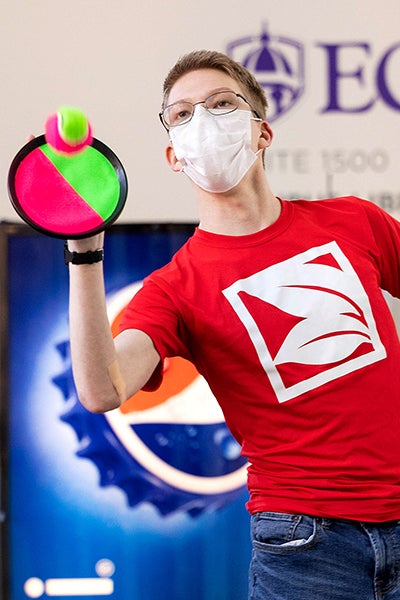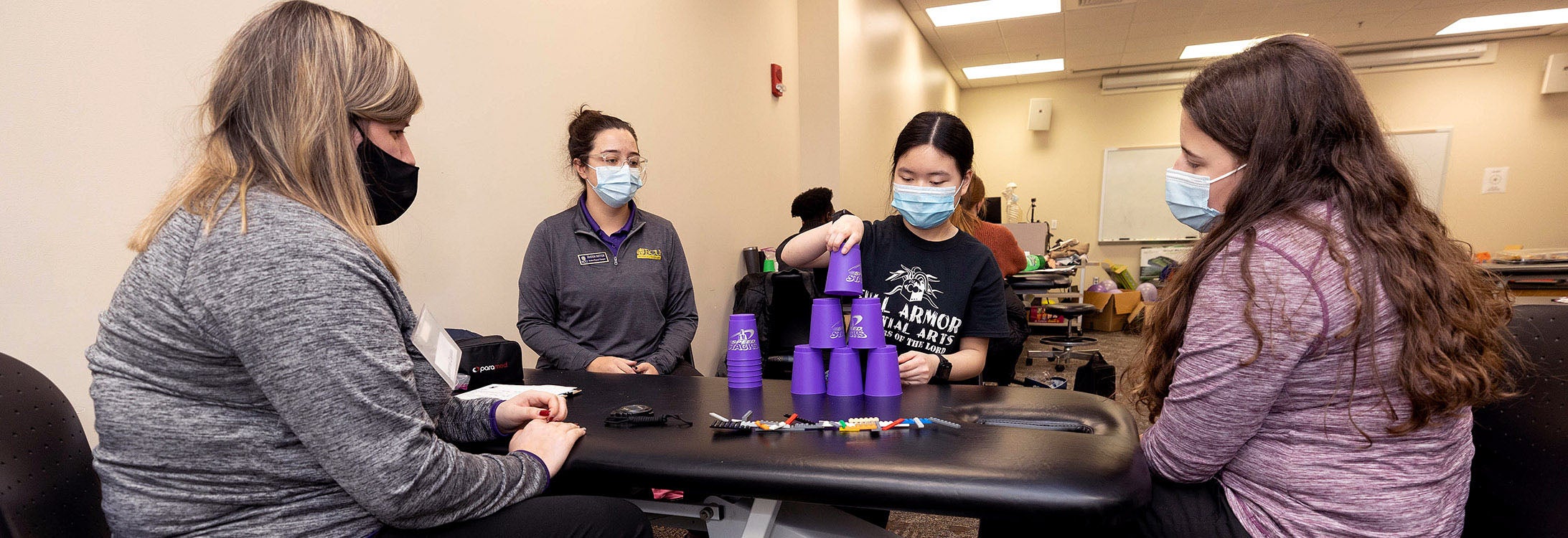HABIT STUDY
ECU program helps children with cerebral palsy access valuable therapy, social opportunities
While many of his peers are being shuttled around to practices and tournaments for their various sports teams, Wyatt Sanson is often traveling to physical therapy, occupational therapy and speech therapy sessions.
And while other 13-year-olds return home with trophies celebrating their athletic successes, Wyatt and his loved ones celebrate like Super Bowl champions when he accomplishes his achievements during these therapy sessions, such as learning to carry a tray of food evenly, how to put on a belt and even playing rock-paper-scissors.
“As a parent, you’re crying inside because you’re so happy for him because what he is doing is just so amazing and you’re excited to see all of his potential,” his mother, Holly Sanson, said. “For us, our trophy is watching him feel more comfortable, confident and excited about learning better ways to function in daily life.”
Wyatt — and about one in 345 children in the United States, according to the Centers for Disease Control and Prevention — has cerebral palsy. Specifically, he has hemiplegic cerebral palsy, which restricts movement on one side of his body.
“He is a very positive and happy kid,” Sanson said. “When he hangs out with other kids, he tries not reveal his weakness, he just figures out how to maneuver so things are easier for him.”
But Wyatt and his mother recently drove nearly five hours from their home in Lexington, S.C., to ECU’s College of Allied Health Sciences, where he had the opportunity to showcase his abilities instead of hiding his inabilities.
For an entire week, the college’s Pediatric Assessment and Rehabilitation Lab (PeARL) in the Department of Physical Therapy hosted a dozen children and teens with hemiplegic cerebral palsy, ages 6-16, for an intensive therapy research study in a camp-like setting.
The Hand Arm Bimanual Intensive Therapy (HABIT) study is funded through an Academy of Pediatric Physical Therapy grant to the principal investigator Dr. Swati Surkar and aims to determine if remote ischemic conditioning — essentially altering blood flow to the affected arm using a blood pressure cuff — combined with the repeated practice of bimanual (two-handed) games and activities can enhance the bimanual skill learning and brain function of children with hemiplegic cerebral palsy.
“The beauty of this study is kids typically get 30-45 minutes of physical therapy twice a week, but it has been shown in research that intensive therapy — for example, 7-8 hours a day for 1-2 weeks — works better both in improvement of hand skills and in brain function,” said Surkar, an assistant professor in the Department of Physical Therapy. “The goal here is to deliver that kind of intensive therapy, but that can be exhausting, so we are doing it in a more playful and camp-like atmosphere.”
‘Bop it! Twist it! Pull it!’
The enthusiasm from the HABIT Study reverberated through the hallways of the College of Allied Health Sciences. Choruses of encouragement from the faculty and student volunteers were only upstaged by the thunderous ovations that echoed whenever one of the study participants accomplished a goal.

Will Cox, 15, plays a game of catch as part of an intensive therapy study at ECU’s College of Allied Health.
From board games and cookie baking, to playing catch and thrilling rounds of the electronic game Bop It, the therapeutic benefits were obvious, as was the excitement of all involved.
“The 9-year-old boy I am working with loves sports, so we’ve played a lot of basketball. We asked him to dribble with his left hand, but he said, ‘I can’t do that!’ But we encouraged him to try, and he was eventually able to do it, so he was really excited, and we were all really excited,” said Mary Scott Faircloth, a second-year doctoral student. “I feel like I’ve learned so much, these kids are all so wonderful. It’s been really cool to see them already seeing a difference in just a few days.”
The faculty members equally enjoyed taking part in the study that gave them the opportunity to determine how to best make the activities clinically appropriate and therapeutic for the children.
“The fun part of being a therapist is pushing people to achieve what that they didn’t know was possible. So, it’s been fun for us to watch them be challenged and then live up to the challenge,” said Dr. Christine Lysaght, clinical associate professor in the Department of Physical Therapy. “But the best part is not just when we’re here motivating them, it’s hoping they carry it with them. When they go home and then come back to tell us that they had an easier time with whatever their goal was – maybe it was tying their shoes – that is always the best part.”
In addition to the encouragement from ECU students and faculty, the participants also fed off the endless encouragement from each other.
Will Cox, a 15-year-old Trinity, N.C. resident, said he wanted to travel to 2.5 hours to Greenville for the study with the goal of improving the range of motion with his right hand and leg, which he said have been essentially paralyzed since he suffered a stroke as a baby.
“I don’t typically think about using my right side and I was hoping that coming here will teach me how to remember to use my right side, so I don’t lose it,” he said.
Midway through the week, Will said he enjoyed overcoming some of the more challenging activities he attempted, such as using different tools from a tool kit with his right hand. But he said the best part was simply being part of the study.
“It’s very encouraging and more fun to be around other people who face the same struggles that I face,” he said. “My favorite part is being around other people with the same issues and realizing I’m not the only one.”
Long-term goals
Tyson Antley called the study “tough,” but the 9-year-old High Point, N.C., resident said that was a good thing because he hopes it will help him achieve three very specific goals:
- To get better at remembering to use his left side.
- To be a doctor, because he likes to help people.
- To play tight end for a football team, because he said he is “tough and can get through people easily.”
The study also provided hope to other participants.
Sanson said Wyatt has asked her, “Mom, am I going to struggle with this the rest of my life?”
“The answer is yes, but we can minimize it. Because people like ECU are coming around and doing clinical research therapies to help us find better ways for them to function in daily life,” she said. “That’s why this study is one of the best things we have ever done, not only for him, but also for our family. He lights up with his positivity after being here because he sees, ‘I might never get to 100% use, but the more I keep working at it, the more and more I’ll be able to do.’”
And after taking part in the study, some of Wyatt’s goals seem more attainable.
“One of the other kids here drives, so the idea of being able to do that was exciting for him,” Sanson said. “And while other kids his age might be annoyed if their parents make them get a job, he is actually looking forward to it and is asking, ‘Mom, when can I get a job?’”
Faculty from the Department of Physical Therapy hope to offer the program to even more participants in the future, especially those from eastern North Carolina, because the need exists.
And if the study shows positive outcomes, Surkar hopes it will one day lead to more clinical translation of these kinds of therapies.
“If the research shows that intensive therapy works, then it’s time to change our clinical practices,” she said. “That is my long-term goal. To strengthen our research so these intensive therapies can be delivered to kids.”
ECU is in the public phase of the Pursue Gold campaign to raise half a billion dollars. This ambitious effort will create new paths to success for Pirates on campus, across the country and around the world. Donor gifts during the campaign will keep us constantly leading and ready to advance what’s possible. Learn more at pursuegold.ecu.edu.
